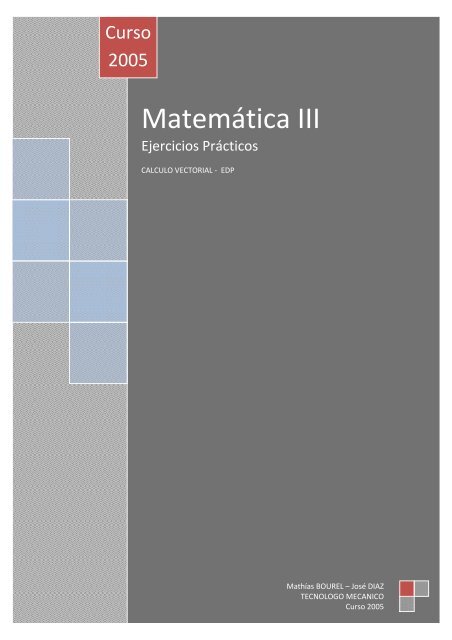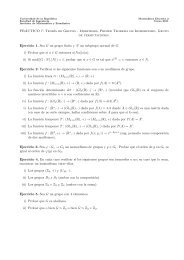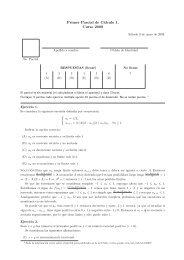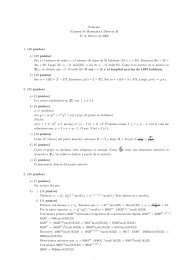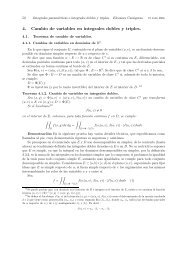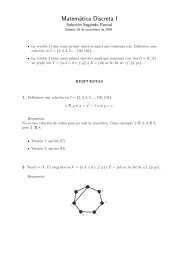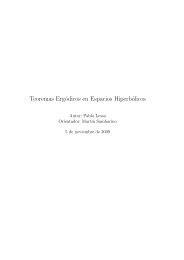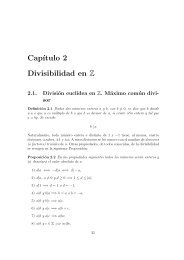Prácticos - IMERL
Prácticos - IMERL
Prácticos - IMERL
You also want an ePaper? Increase the reach of your titles
YUMPU automatically turns print PDFs into web optimized ePapers that Google loves.
Curso<br />
2005<br />
Matemática III<br />
Ejercicios <strong>Prácticos</strong><br />
CALCULO VECTORIAL ‐ EDP<br />
Mathías BOUREL – José DIAZ<br />
TECNOLOGO MECANICO<br />
Curso 2005
TECNOLOGO MECANICO - MATEMATICA III<br />
(curso 2005)<br />
LISTA DE EJERCICIOS N o 1<br />
Integrales dobles<br />
1. Hallar los límites de integración, en un sentido y en el otro, para la integral doble <br />
D la siguiente región:<br />
(a) D es el rectángulo de vértices O = (0, 0), A = (2, 0), B = (2, 1), C = (0, 1)<br />
(b) D es el triángulo de vértices O = (0, 0), A = (1, 0), B = (1, 1)<br />
(c) D es el trapecio de vértices O = (0, 0), A = (2, 0), B = (1, 1), C = (0, 1)<br />
D<br />
f(x, y)dxdy siendo<br />
2. Dibujar la región de integración e invertir el orden de integración<br />
(a) <br />
2 <br />
0<br />
f(x, y)dy dx 1 −1 (b) <br />
1 <br />
1<br />
f(x, y)dy dx 0 x (c) <br />
2 2y<br />
0 y2 (e)<br />
<br />
f(x, y)dx dy<br />
<br />
3 <br />
2x<br />
f(x, y)dy dx 1 x (f) <br />
2 2−x<br />
−6 x2 <br />
−4 f(x, y)dy dx<br />
4<br />
(g) √ <br />
3−y<br />
f(x, y)dx dy<br />
<br />
1 √ <br />
x+1 √<br />
0<br />
x f(x, y)dy dx<br />
2<br />
(i) 1<br />
−1<br />
3. Calcular <br />
√<br />
3−y<br />
f(x, y)dx<br />
−y+1<br />
D<br />
f(x, y)dxdy .<br />
dy + 3<br />
1<br />
0<br />
(a) f : f(x, y) = x sin(y) − ye x y D = {(x, y) ∈ R 2 : −1 ≤ x ≤ 1, 0 ≤ y ≤ π<br />
2 }<br />
(b) f : f(x, y) = xy y D = {(x, y) ∈ R 2 : x ≤ 0, y 2 − 2y ≤ x}<br />
(c) f : f(x, y) = 2x + 3y y D = {(x, y) ∈ R 2 : y ≥ 0, y ≥ x, x − 2y + 1 ≥ 0}<br />
(d) f : f(x, y) = |x + y − 1| y D = {(x, y) ∈ R 2 : 0 ≤ x ≤ 1, 0 ≤ y ≤ 1}<br />
4. Calcular <br />
(a)<br />
(c)<br />
<br />
<br />
D<br />
PRACTICOS CURSO 2005<br />
MATEMATICA III<br />
f(x, y)dxdy utilizando un cambio de variable lineal.<br />
f : f(x, y) = cos(x − y) cos(x + 2y)<br />
D = {(x, y) ∈ R 2 : −2x ≤ y ≤ 0, x ≤ y + π}<br />
f : f(x, y) = (x − y) 2 sin 2 (x + y)<br />
D = {(x, y) ∈ R 2 : |x − π| + |y − π| ≤ π}<br />
1<br />
(b)<br />
(d)<br />
⎧<br />
⎪⎨<br />
⎪⎩<br />
⎧<br />
⎪⎨<br />
⎪⎩<br />
Página 1 de 23<br />
f : f(x, y) = (x − y)e x2 −y 2<br />
D es el cuadrado de vértices<br />
(2, 1), (0, 1), (1, 0), (1, 2)<br />
f : f(x, y) = e −(x+y)2<br />
D es el triángulo de vértices<br />
(0, 0), (0, 1), (1, 0)<br />
Mathías BOUREL - José DIAZ
5. Calcular <br />
D<br />
f(x, y)dxdy utilizando coordenadas polares.<br />
(a) f : f(x, y) = x 2 + y 2 y D = {(x, y) ∈ R 2 : x ≥ 0, y ≥ 0, x 2 + y 2 ≤ 1}<br />
(b) f : f(x, y) = x 2 y 2 y D = {(x, y) ∈ R 2 : x 2 + y 2 ≤ 1} 1<br />
(c) f : f(x, y) = x3 + y3 − 3xy x2 + y2 <br />
(x2 + y2 ) 3<br />
(d) f : f(x, y) =<br />
y D = {(x, y) ∈ R 2 : x 2 + y 2 ≤ 1}<br />
x<br />
x 2 + y 2 + 1 y D = {(x, y) ∈ R2 : x 2 + y 2 − 4y ≤ 0, x ≥ 0}<br />
(e) f : f(x, y) = x 2 + y 2 y D = {(x, y) ∈ R 2 : x 2 + y 2 ≤ 2x}<br />
(f) f : f(x, y) =<br />
1<br />
x 2 + y 2<br />
PRACTICOS CURSO 2005<br />
MATEMATICA III<br />
y D = {(x, y) ∈ R 2 : |x| ≤ 1, |y| ≤ 1}<br />
6. (a) Calcular <br />
<br />
1 − D<br />
x2 y2<br />
4 − 9 dxdy siendo D = {(x, y) ∈ R2 : x2 y2<br />
4 + 9 ≤ 1}<br />
Sugerencia: Utilizar las siguientes coordenadas x = 2rcosϕ, y = 3rsenϕ<br />
(b) Calcular x<br />
D<br />
2<br />
x2 + y dxdy siendo D = {(x, y) ∈ R2 : x ≤ 0, 1 ≤ y ≤ 2 − x2 }<br />
Sugerencia: realizar el cambio de variable x = √ v − u, y = u + v<br />
<br />
7. Calcular el área de la región plana D = (x, y) ∈ R2 : x2 + y2 <br />
2 2 2 ≤ x − y , x ≥ 0<br />
1 Recordar que cos 2x = 2 cos 2 x − 1 y cos 4x = 8 cos 4 x − 8 cos 2 x + 1<br />
2<br />
Página 2 de 23<br />
Mathías BOUREL - José DIAZ
TECNOLOGO MECANICO - MATEMATICA III<br />
(curso 2005)<br />
LISTA DE EJERCICIOS N o 2<br />
Integrales triples<br />
1. Hallar los límites de integración, en los seis ordenes posibles, para la integral triple <br />
f(x, y, z)dxdydz<br />
E<br />
siendo E el tetraedro sólido limitado por los planos x = 0, y = 0, z = 0, 2x + y + z = 4.<br />
2. Hallar los límites de integración (en dos ordenes) para la integral triple <br />
f(x, y, z)dxdydz siendo E el<br />
E<br />
sólido acotado limitado<br />
(a) por el cilindro x 2 + y 2 = 1, y los planos z = 0, z = 1.<br />
(b) por el cono z 2 = x 2 + y 2 y los planos z = 0, z = 1.<br />
(c) por el paraboloide z = x 2 + y 2 , y los planos z = 0, z = 1.<br />
3. Hallar los límites de integración (bastará con un solo orden) para la integral triple <br />
siendo E el sólido acotado limitado<br />
(a) por el cilindro x 2 + y 2 = 1, y los planos z = 1, z = 4.<br />
(b) por el cono z 2 = x 2 + y 2 y los planos z = 1, z = 4.<br />
(c) por el paraboloide z = x 2 + y 2 y los planos z = 1, z = 4.<br />
4. Calcular <br />
E<br />
f(x, y, z)dxdydz .<br />
E<br />
f(x, y, z)dxdydz<br />
(a) f : f(x, y, z) = x + y + z y E = {(x, y, z) ∈ R3 : 0 ≤ x ≤ 1, −1 ≤ y ≤ 2, 0 ≤ z ≤ 3}<br />
1<br />
(b) f : f(x, y, z) =<br />
3<br />
(1 + x + y + z)<br />
plano x + y + z = 1.<br />
y E es el sólido acotado limitado por los planos coordenados y el<br />
(c) f : f(x, y, z) = xyz y E = {(x, y, z) ∈ R 3 : 0 ≤ x, 0 ≤ y, 0 ≤ z, x 2 + y 2 + z 2 ≤ 1}<br />
(d) f : f(x, y, z) = xy 2 z 3 y E es el sólido acotado limitado por la superficie z = xy y los planos<br />
y = 0, z = 0, y = x y x = 1.<br />
(e) f : f(x, y, z) = x y E es sólido acotado limitado por los planos x = 0, y = 0, z = 2 y la superficie<br />
z = x 2 + y 2 , x ≥ 0, y ≥ 0.<br />
5. Calcular el volumen, primero utilizando integrales dobles y luego integrales triples, del sólido S acotado<br />
limitado<br />
(a) por los planos z = 0, y = 0, y = x, x + y = 2, x + y = 3 y x + y + z = 6.<br />
(b) por le cilindro x = y 2 y los planos z = 0 y x + z = 1.<br />
(c) por el paraboloide z = 1 − x 2 − y 2 y el plano z = 0<br />
(d) por los paraboloides z = x 2 + y 2 y x 2 + y 2 + z = 8.<br />
6. Calcular <br />
D<br />
f(x, y, z)dxdydz utilizando un cambio de coordenadas esféricas<br />
√<br />
(x2 +y2 +z2 3 ) (a) f(x, y, z) = e<br />
PRACTICOS CURSO 2005<br />
MATEMATICA III<br />
y D = {(x, y, z) ∈ R 3 : x 2 + y 2 + z 2 ≤ 1}<br />
1<br />
Página 3 de 23<br />
Mathías BOUREL - José DIAZ
(b) f(x, y, z) = x 2 + y 2 + z 2 y D = {(x, y, z) ∈ R 3 : x 2 + y 2 + z 2 ≤ r 2 }<br />
(c) f(x, y, z) = x 2 + y 2 + z 2 xyz y D = {(x, y, z) ∈ R 3 : x 2 + y 2 + z 2 ≤ r 2 }<br />
7. Calcular <br />
D<br />
f(x, y, z)dxdydz utilizando un cambio de coordenadas cilindricas<br />
(a) f(x, y, z) = z x 2 + y 2 y D = {(x, y, z) ∈ R 3 : 0 ≤ x ≤ 2, 0 ≤ y ≤ √ 2x − x 2 , 0 ≤ z ≤ 4}<br />
(b) f(x, y, z) =<br />
1<br />
x 2 + y 2 + z 2<br />
PRACTICOS CURSO 2005<br />
MATEMATICA III<br />
y D = {(x, y, z) ∈ R 3 : 1<br />
2 ≤ z ≤ 1, x2 + y 2 + z 2 ≤ 1}<br />
2<br />
Página 4 de 23<br />
Mathías BOUREL - José DIAZ
"<br />
# $<br />
! %<br />
& ' ! (<br />
! ) $<br />
" ( '<br />
$<br />
PRACTICOS CURSO 2005<br />
MATEMATICA III<br />
Página 5 de 23<br />
!<br />
Mathías BOUREL - José DIAZ
* + # !<br />
$<br />
! ' ' '<br />
, - ! !<br />
+ #<br />
. %<br />
/ - ! %<br />
+<br />
( 2, 0, 2 )<br />
PRACTICOS CURSO 2005<br />
MATEMATICA III<br />
( 0, 2, 2 )<br />
! %(<br />
0 ( 0 (<br />
! %(<br />
!<br />
!<br />
Página 6 de 23<br />
Mathías BOUREL - José DIAZ
1 - ! %<br />
+<br />
$<br />
2 - '<br />
4<br />
!<br />
- 3<br />
+ 3<br />
- ! %<br />
4 #<br />
( !<br />
. % $<br />
- ! %<br />
! (<br />
- ! %<br />
(0,0)<br />
PRACTICOS CURSO 2005<br />
MATEMATICA III<br />
#<br />
! %(<br />
5 % ( 6<br />
(1,0)<br />
(1,1)<br />
Página 7 de 23<br />
Mathías BOUREL - José DIAZ
"<br />
! !<br />
# $ %$ % & '<br />
% (! $ % %<br />
#<br />
U<br />
PRACTICOS CURSO 2005<br />
MATEMATICA III<br />
) $<br />
D<br />
C +<br />
C2<br />
C 1<br />
Página 8 de 23<br />
Mathías BOUREL - José DIAZ
* ) %$<br />
+ ) %$ #<br />
(0,0)<br />
C<br />
(<br />
' (!<br />
) " ' ! (!<br />
) +<br />
, ' (!<br />
p 3<br />
C 3<br />
- # ' . ! / #<br />
'<br />
0 ) %$<br />
PRACTICOS CURSO 2005<br />
MATEMATICA III<br />
p 2<br />
( # ' (!<br />
- %$ %$ %$<br />
C 2<br />
p 1<br />
C1<br />
C<br />
Página 9 de 23<br />
Mathías BOUREL - José DIAZ
! " "<br />
# $ %<br />
#<br />
& '<br />
( ) ' $<br />
" ) " " *<br />
#<br />
# ) %<br />
&<br />
+ !<br />
" "<br />
& ' , "<br />
#<br />
%<br />
PRACTICOS CURSO 2005<br />
MATEMATICA III<br />
# "<br />
Página 10 de 23<br />
Mathías BOUREL - José DIAZ
#<br />
-<br />
"<br />
' '<br />
. '<br />
/ !<br />
#<br />
" "<br />
PRACTICOS CURSO 2005<br />
MATEMATICA III<br />
/<br />
'<br />
/<br />
+<br />
Página 11 de 23<br />
Mathías BOUREL - José DIAZ
. -<br />
& '<br />
# " "<br />
-<br />
& '<br />
" "<br />
# % * '<br />
0 ' !<br />
#<br />
" "<br />
& ' ,<br />
# " "<br />
-<br />
PRACTICOS CURSO 2005<br />
MATEMATICA III<br />
"<br />
+<br />
Página 12 de 23<br />
Mathías BOUREL - José DIAZ
!<br />
!<br />
!<br />
! " # "<br />
$<br />
! %<br />
! & " " " ' &<br />
! ! " '<br />
' !<br />
' !<br />
( ) " * #<br />
+ , ! - $<br />
"<br />
!<br />
" "<br />
% . ' * # ) + , -<br />
$" '<br />
(<br />
PRACTICOS CURSO 2005<br />
MATEMATICA III<br />
'<br />
% '<br />
Página 13 de 23<br />
Mathías BOUREL - José DIAZ
" ) + , ! ' " 0<br />
# '<br />
! " "<br />
( 1 ! " 2<br />
' " " 1 " " " (<br />
!<br />
2 ' " " " " "<br />
1 + " ( !<br />
3<br />
4 + "<br />
5 + " '<br />
3<br />
6<br />
3 "<br />
& $<br />
'<br />
PRACTICOS CURSO 2005<br />
MATEMATICA III<br />
C<br />
!<br />
Página 14 de 23<br />
Mathías BOUREL - José DIAZ
PRACTICOS CURSO 2005<br />
MATEMATICA III<br />
'<br />
Página 15 de 23<br />
Mathías BOUREL - José DIAZ<br />
(
!<br />
" # $<br />
" '<br />
( ) " & *<br />
"<br />
+ , *<br />
, *<br />
" , *<br />
,<br />
- ) " &<br />
PRACTICOS CURSO 2005<br />
MATEMATICA III<br />
% % &<br />
' %<br />
" ./ 0 1 %&<br />
Página 16 de 23<br />
Mathías BOUREL - José DIAZ
2 %<br />
3<br />
) " &<br />
" ) " & ( 4 ' 5<br />
) " & 6" * & '<br />
7 %<br />
3<br />
PRACTICOS CURSO 2005<br />
MATEMATICA III<br />
* 9 * 3 *<br />
" " & &<br />
%<br />
" & &<br />
8<br />
* % !<br />
Página 17 de 23<br />
Mathías BOUREL - José DIAZ
PRACTICOS CURSO 2005<br />
MATEMATICA III<br />
TECNOLOGO MECANICO - MATEMATICA III - curso 2005<br />
LISTA DE EJERCICIOS N o 8<br />
Ecuaciones en derivadas parciales<br />
(E.D.P.)<br />
Ecuación del calor<br />
1. Hallar una solución formal de los siguientes problemas:<br />
⎧<br />
⎧<br />
ut = 3uxx 0 < x < 2, t > 0<br />
⎪⎨<br />
⎪⎨<br />
u (x, 0) = sen (πx) 0 ≤ x ≤ 2<br />
(a)<br />
(b)<br />
⎪⎩<br />
u (0, t) = 0 t > 0<br />
⎪⎩<br />
u (2, t) = 0 t > 0<br />
Series de Fourier<br />
2. Hallar la serie de Fourier de la función f : R → R tal que<br />
<br />
x<br />
<br />
(a) f(x) = sin<br />
2<br />
(b) f(x) = cos (2x)<br />
(c) f(x) = cos3 x + sin 2 x Sugerencia: cos3 x =<br />
ut = 1<br />
4 uxx 0 < x < 2, t > 0<br />
u (x, 0) = 2sen π<br />
2 x − sen (πx) + 4sen (2πx) 0 ≤ x ≤ 2<br />
u (0, t) = 0 t > 0<br />
u (2, t) = 0 t > 0<br />
cos 3x+3 cos x<br />
4<br />
y sin 2 x =<br />
1−cos 2x<br />
2<br />
Página 18 de 23<br />
3. Se considera la función f : R → R periódica de periódo T<br />
(a) f(x) = x2 si x ∈ − π<br />
<br />
π<br />
2 , 2 y T = π (b) f(x) = x si x ∈ − π<br />
<br />
π<br />
⎧<br />
2 , 2 y T = π<br />
⎪⎨ 1 si x ∈ (0, π)<br />
<br />
1<br />
(c) f(x) = −1 si x ∈ (−π, 0) y T = 2π (d) f : f(x) = 2 − x si x ∈ [0, 1]<br />
y T = 2<br />
⎪⎩<br />
1<br />
2 + x si x ∈ [−1, 0]<br />
0 si x = 0 o x = ±π<br />
(e) f : f(x) = x2 ⎧<br />
2 si x = 0<br />
⎪⎨<br />
x si x ∈ (0, 4)<br />
si x ∈ [−1, 1] y T = 4 (f) f : f(x) =<br />
y T = 8<br />
⎪⎩<br />
4 si x ∈ [4, 8)<br />
2 si x = 8<br />
i. Representar graficamente a la función en R<br />
ii. Estudiar la paridad o imparidad de f<br />
iii. Hallar la serie de Fourier asociada a la función f<br />
iv. Representar graficamente a la función a que converge la serie de Fourier hallada<br />
4. Hallar la serie de Fourier de senos y la serie de Fourier de cosenos de la función f : (0, π) → R tal que<br />
<br />
1 si x ∈<br />
(a) f(x) = x (b) f(x) = 1 (c) f(x) = π − x (d) f(x) =<br />
0, π<br />
<br />
2<br />
0 si x ∈ π<br />
2 , 1<br />
Ecuación del calor (continuación)<br />
5. Hallar una solución formal de los siguientes problemas<br />
⎧<br />
ut = uxx 0 < x < π, t > 0<br />
⎪⎨<br />
u (x, 0) = x<br />
(a)<br />
⎪⎩<br />
π2 − x2 ⎧<br />
ut = uxx <br />
0 < x < 2, t > 0<br />
⎪⎨<br />
x si x ∈ [0, 1]<br />
0 ≤ x ≤ π<br />
u (x, 0) =<br />
0 ≤ x ≤ 2<br />
(b)<br />
2 − x si x ∈ [1, 2]<br />
u (0, t) = 0 t > 0<br />
u (0, t) = 0 t > 0<br />
u (π, t) = 0 t > 0<br />
⎪⎩<br />
u (2, t) = 0 t > 0<br />
Mathías BOUREL - José DIAZ<br />
1
2<br />
6. Hallar una solución formal del problema<br />
⎧<br />
⎪⎨<br />
⎪⎩<br />
ut = uxx 0 < x < 2, t > 0<br />
u (x, 0) = 100 0 ≤ x ≤ 2<br />
u (0, t) = 20 t > 0<br />
u (2, t) = 60 t > 0<br />
7. Hallar la serie de Fourier de la función f : R → R tal que<br />
<br />
x<br />
<br />
(a) f(x) = sin<br />
2<br />
(b) f(x) = cos (2x)<br />
(c) f(x) = cos3 x + sin 2 x Sugerencia: cos3 x =<br />
cos 3x+3 cos x<br />
4<br />
8. Se considera la función f : R → R periódica de periódo T<br />
<br />
π , 2<br />
PRACTICOS CURSO 2005<br />
MATEMATICA III<br />
y sin 2 x =<br />
1−cos 2x<br />
2<br />
(a) f(x) = x2 si x ∈ − π<br />
2 y T = π (b) f(x) = x si x ∈ − π<br />
⎧<br />
2 y T = π<br />
⎪⎨ 1 si x ∈ (0, π)<br />
<br />
1<br />
(c) f(x) = −1 si x ∈ (−π, 0) y T = 2π (d) f : f(x) = 2 − x si x ∈ [0, 1]<br />
y T = 2<br />
⎪⎩<br />
1<br />
2 + x si x ∈ [−1, 0]<br />
0 si x = 0 o x = ±π<br />
(e) f : f(x) = x2 ⎧<br />
2 si x = 0<br />
⎪⎨<br />
x si x ∈ (0, 4)<br />
si x ∈ [−1, 1] y T = 4 (f) f : f(x) =<br />
y T = 8<br />
⎪⎩<br />
4 si x ∈ [4, 8)<br />
2 si x = 8<br />
(a) i. Representar graficamente a la función en R<br />
ii. Estudiar la paridad o imparidad de f<br />
iii. Hallar la serie de Fourier asociada a la función f<br />
iv. Representar graficamente a la función que converge la serie de Fourier hallada<br />
9. Hallar la serie de Fourier de senos y la serie de Fourier de cosenos de la función f : (0, π) → R tal que<br />
(a) f(x) = x (b) f(x) = 1 (c) f(x) = π − x<br />
<br />
(d) f(x) =<br />
1 si x ∈ 0, π<br />
0<br />
<br />
2<br />
si x ∈ π<br />
2 , 1<br />
10. Usar el método de separación de variables de Fourier para hallar una solución formal del siguiente problema<br />
⎧<br />
ut = 4uxx 0 < x < π, t > 0<br />
⎪⎨<br />
u (x, 0) = sin<br />
⎪⎩<br />
1<br />
2x − sin 3<br />
2x 0 ≤ x ≤ π<br />
u (0, t) = 0 t > 0<br />
ux (π, t) = 0 t > 0<br />
<br />
π , 2<br />
Página 19 de 23<br />
Mathías BOUREL - José DIAZ
TECNOLOGO MMECANICO -ATEMATICA III - curso 2005<br />
LISTA DE EJERCICIOS N o 9<br />
Ecuaciones en derivadas parciales<br />
(E.D.P.)<br />
Ecuación de la onda<br />
1. Hallar una solución formal de los siguientes problemas<br />
⎧<br />
utt = 9uxx<br />
⎪⎨ u(0, t) = 0<br />
0 < x < π, t > 0<br />
t ≥ 0<br />
⎧<br />
utt = uxx<br />
⎪⎨ u(0, t) = 0<br />
0 < x < 1, t > 0<br />
t ≥ 0<br />
(a) u(π, t) = 0 t ≥ 0<br />
u(x, 0) = sin(3x) 0 ≤ x ≤ π<br />
⎪⎩<br />
ut(x, 0) = 0 0 ≤ x ≤ π<br />
⎧<br />
utt = uxx<br />
⎪⎨ u(0, t) = 0<br />
(b) u(1, t) = 0<br />
⎪⎩<br />
0 < x < π, t > 0<br />
t ≥ 0<br />
t ≥ 0<br />
(c)<br />
⎪⎩<br />
u(π, t) = 0 t ≥ 0<br />
u(x, 0) = x (π − x) 0 ≤ x ≤ π<br />
ut(x, 0) = 1 0 ≤ x ≤ π<br />
2. Resolver el problema ⎧<br />
⎪⎨ utt = 4uxx x ∈ R, t > 0<br />
u(x, 0) = 0<br />
⎪⎩<br />
ut(x, 0) = x<br />
x ∈ R<br />
x ∈ R<br />
por el método de propagación de D’Alembert<br />
3. Se considera la ecuación de onda<br />
utt = 9uxx<br />
sujeta a las condiciones iniciales<br />
<br />
2 si − 1 < x < 1<br />
u (x, 0) =<br />
0 en caso contrario<br />
u(x, 0) = − 1<br />
12x4 + 1<br />
6x3 − 1<br />
12x 0 ≤ x ≤ 1<br />
ut(x, 0) = 0 0 ≤ x ≤ 1<br />
y ut (x, 0) = 0, x ∈ R<br />
Trace la gráfica de la solución del problema anterior en t = 0, t = 1 1<br />
6 , t = 3<br />
4. (a) Resolver el problema<br />
PRACTICOS CURSO 2005<br />
MATEMATICA III<br />
⎧<br />
⎪⎨<br />
⎪⎩<br />
utt = uxx<br />
x ∈ R, t > 0<br />
u(x, 0) = sin x x ∈ R<br />
ut(x, 0) = 1 x ∈ R<br />
por el método de propagación de D’Alembert<br />
(b) ¿Cómo es la gráfica de cuerda en el instante t = π<br />
2 ?<br />
y t = 2<br />
3 .<br />
Página 20 de 23<br />
Mathías BOUREL - José DIAZ<br />
3
4<br />
5. (a) Mostrar que la función v(x, t) = −x sent es solución.de la ecuación utt = uxx + x sent<br />
(b) Hallar una solución formal del siguiente problema<br />
⎧<br />
⎪⎨<br />
⎪⎩<br />
PRACTICOS CURSO 2005<br />
MATEMATICA III<br />
utt = uxx + x sent 0 < x < π, t ∈ R<br />
u(0, t) = 0 t ≥ 0<br />
u(π, t) = −πsent t ≥ 0<br />
u(x, 0) = +∞ sen nx<br />
n=1 n4 0 ≤ x ≤<br />
ut(x, 0) = −x + +∞ sen nx<br />
n3 0 ≤ x ≤ π<br />
Página 21 de 23<br />
n=1<br />
Sugerencia: hacer el cambio de variables u = w + v donde w será solución de un problema más sencillo que<br />
se determinará<br />
6. .Usar el método de separación de variables de Fourier para hallar una solución formal del siguiente PVIF<br />
⎧<br />
⎪⎨<br />
utt = uxx<br />
ux(0, t) = 0<br />
0 < x < π, t ∈ R<br />
t ≥ 0<br />
⎪⎩<br />
ux(π, t) = 0<br />
u(x, 0) = π − x<br />
ut(x, 0) = x<br />
t ≥ 0<br />
0 ≤ x ≤ π<br />
0 ≤ x ≤ π<br />
Mathías BOUREL - José DIAZ
LISTA DE EJERCICIOS N o 10<br />
Ecuaciones en derivadas parciales<br />
(E.D.P.)<br />
Ecuación de Laplace<br />
1. Resolver uxx + uyy = 0, en (0, π) × (0, π), con las condiciones:<br />
(a)<br />
⎧<br />
⎪⎨<br />
⎪⎩<br />
2. Se considera la ecuación<br />
u(0, y) = 0<br />
u(π, y) = 0<br />
u(x, π) = 0<br />
u(x, 0) = 4 sen3x<br />
(b)<br />
<br />
u(0, y) = u(π, y) = seny<br />
u(x, π) = u(x, 0) = x(π − x)<br />
uxx + uyy = 2 en el retángulo Ω = (0, π) × (0, π)<br />
(a) Probar que v : v (x, y) = x2 + x + 1 es solución<br />
(b) Hallar una solución formal de dicha ecuación que verifique además las siguientes condiciones:<br />
⎧<br />
u(x, 0) = x<br />
⎪⎨<br />
2 ∞ sen nx<br />
+ x + 1 +<br />
n4 , ∀ x ∈ [0, π]<br />
⎪⎩<br />
1<br />
u(x, π) = x2 + x + 1 + sen x , ∀ x ∈ [0, π]<br />
u(0, y) = 1 , ∀ y ∈ [0, π]<br />
u(π, y) = π2 + π + 1 , ∀ y ∈ [0, π]<br />
Sugerencia: hacer el cambio de variables u = w + v donde w será solución de un problema más sencillo que<br />
se determinará.<br />
3. Se considera la ecuación:<br />
(E) uxx + uyy + 4ux + 4uy = e y <br />
cos x en el retángulo Ω =<br />
a) Mostrar que v : v(x, y) = 1<br />
8 ey (cos x + sen x) es una solución de (E).<br />
0 < x < π<br />
0 < y < 1<br />
b) Hallar una solución formal de dicha ecuación que verifique además las siguientes condiciones:<br />
u(0, y) = 1<br />
8 ey ∀y ∈ [0, 1]<br />
u(π, y) = − 1<br />
8 ey ∀y ∈ [0, 1]<br />
u(x, 0) = 1<br />
8 (cos x + sen x) + e−2x ∞ sen nx<br />
n=1 n2 u(x, 1) = 1<br />
8 e (cos x + sen x) ∀x ∈ [0, π]<br />
∀x ∈ [0, π]<br />
Sugerencia: hacer el cambio de variables u = w + v donde w será solución de un problema más sencillo que<br />
se determinará.<br />
PRACTICOS CURSO 2005<br />
MATEMATICA III<br />
Página 22 de 23<br />
Mathías BOUREL - José DIAZ<br />
5
6<br />
4. Se considera la ecuación en derivadas parciales<br />
PRACTICOS CURSO 2005<br />
MATEMATICA III<br />
(E) uxx + uyy + 2ux + 2uy = 12 + 8x + 24y en el retángulo Ω =<br />
<br />
0 < x < π<br />
0 < y < 1<br />
(a) Hallar una función polinómica p homogénea de segundo grado que sea solución de (E)<br />
Solución: p : p(x, y) = x 2 + 2xy + 5y 2<br />
(b) Usando el método de separación de variables de Fourier hallar una solución formal de dicha ecuación<br />
que verifique además las siguientes condiciones:<br />
u (x, 0) = x2 ∞ −x sen (nx)<br />
+ e<br />
n=1 n2 u (π, y) = π 2 + 5y 2 + 2πy ∀y ∈ [0, 1]<br />
u (x, 1) = x 2 + 2x + 5 ∀x ∈ [0, π]<br />
u (0, y) = 5y 2 ∀y ∈ [0, 1]<br />
∀x ∈ [0, π]<br />
Página 23 de 23<br />
Mathías BOUREL - José DIAZ


